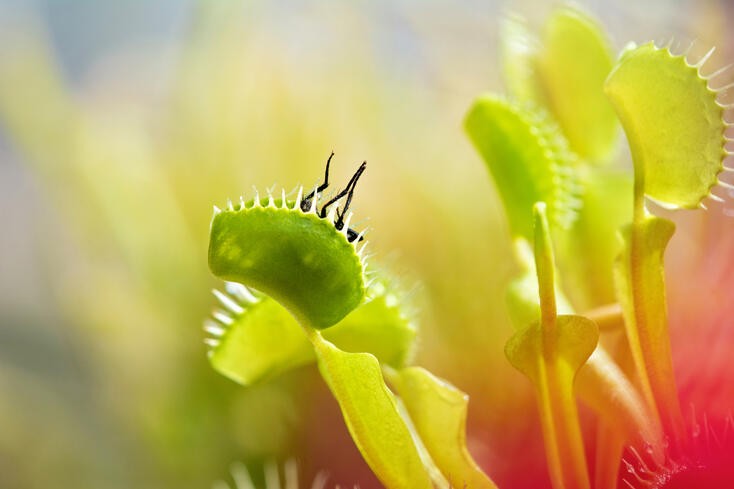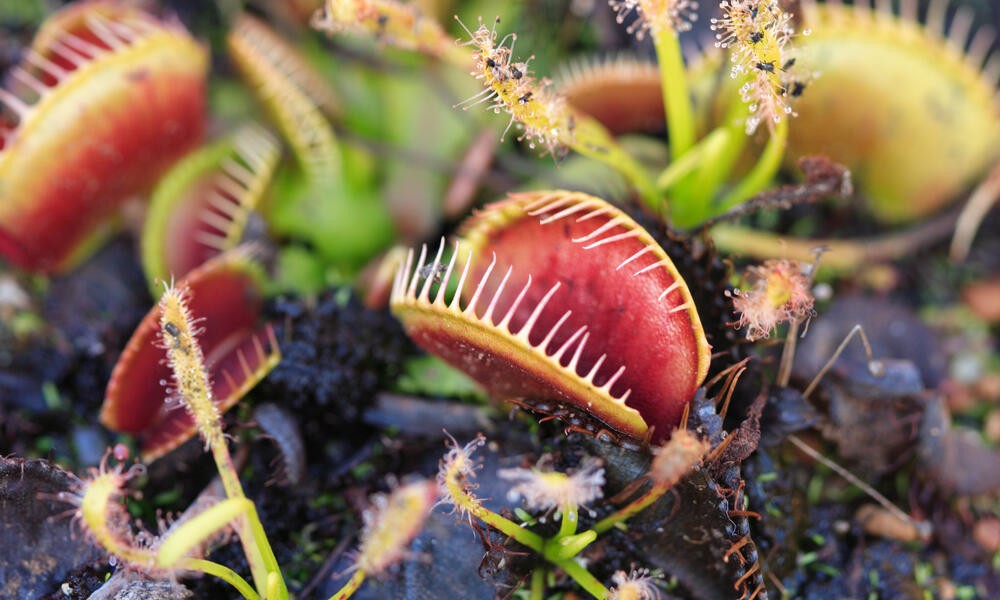As a houseplant, the Venus flytrap or Dionaea muscipula is hard to beat for exoticism. We give tips on the proper care and “feeding” of the famous carnivorous plant.
Venus flytrap or Dionaea muscipula occupies a special position even among exotic houseplants: In the whole world there is hardly anyone who does not know the carnivorous plant. The carnivore from the sundew family was originally found exclusively in North and South Carolina. But that was a long time ago. Today, the bizarre plant from America decorates windowsills and rooms around the globe.
Contents
- 1 Appearance of the Venus flytrap (Dionaea muscipula)
- 2 The Venus flytrap hinged traps
- 3 Insects instead of fertilizer
- 4 The right location for the Venus flytrap
- 5 What kind of soil does Dionaea muscipula need?
- 6 How to water the Venus flytrap?
- 7 When and how to repot Venus Fly Traps?
- 8 Do you need to prune the Venus flytrap?
- 9 Methods of propagation of Dionaea muscipula
- 10 The most common mistakes
- 11 Author
Appearance of the Venus flytrap (Dionaea muscipula)
Dionaea muscipula remains small and also grows very slowly. It usually takes three to four years for the first flower to appear, which is why many people do not even know that the Venus flytrap flowers at all. However, its flowers, which are delicate white star-shaped flowers, are real beauties. They appear from May to July and stand high up on stems up to 30 centimeters long. In this way, they are far enough away from the “false flowers”, that is, the insect-killing clap traps of the plant. This is important because it prevents the necessary pollinating insects from accidentally eating them. The clap traps are the leaves of the carnivorous plant. The roots of the Venus flytrap are only weakly developed and grow more to the side than in depth. Unlike other plants, however, they do not serve to absorb nutrients, but merely hold Dionaea muscipula in the soil and supply it with water.
The Venus flytrap hinged traps
The most interesting thing about the Venus flytrap is, of course, its trapping method. This can be considered as a kind of sophisticated survival strategy, not to say an evolutionary feat. Thanks to its hinged traps, Dionaea muscipula is able to get all the nutrients it lacks in the soil, but which it absolutely needs to survive, from the air.
The carnivorous plant forms oval trap leaves, which are covered with feeler bristles on the edges. They resemble spiny teeth. The catch leaves are actually green, but turn an intense red when exposed to sunlight and secrete a special type of nectar. In short, the leaves pretend to be a flower and thus attract insects. When an insect approaches and touches the sensitive feeler bristles of the Venus flytrap, the trap snaps shut in a flash and remains closed until the insect is completely digested. Due to enzymes and digestive juices produced by Dionaea muscipula in the snap traps, it takes about one to two weeks for the victim to decompose – all that remains is the insect’s robust chitinous carapace. All the nutrients have been extracted from it and prepared in such a way that the Venus fly plant can use them optimally for itself.
Attention: As tempting as it may be, each closing of its hinged traps costs Dionaea muscipula an enormous amount of energy. As a natural protection against wasting energy, the sensing leaves do not respond to one-time stimuli, but must be stimulated several times. Nevertheless, avoid feeding the plant. The plant takes care of itself best. Feeding by hand and provoking collapse too often will cause the Venus flytrap to die prematurely.
Insects instead of fertilizer

Like all carnivorous plants, Dionaea muscipula gets the nutrients it needs from its victims. The prey of the Venus flytrap is primarily insects such as flies, mosquitoes, ants, spiders, wasps or the various species of bumblebees. In its natural habitat, however, it also catches other animals, such as small frogs. For indoor culture, this means that fertilizing is unnecessary.
The right location for the Venus flytrap
The Venus flytrap likes it sunny and warm. If it is too dark, it will not turn red. Avoid drafts at all costs, Dionaea muscipula is sensitive to them. Also important is increased humidity: the higher, the better. In winter, the Venus flytrap goes into a kind of hibernation. During this time, it forms new leaves, that is, still inactive mini traps for the next season. During winter dormancy Dionaea muscipula should move to a place that continues to be very bright, but cool.
What kind of soil does Dionaea muscipula need?
To thrive, the Venus flytrap needs a special carnivore substrate that is low in nutrients, acidic and, most importantly, lime-free. You can get this type of soil at specialty stores and well-stocked garden centers and nurseries.
How to water the Venus flytrap?
For most of the year, the soil should be constantly moist. However, do not water Dionaea muscipula, but place the plant together with the pot in a saucer with water. The right amount of moisture will get into the substrate through the drainage holes. Use only rainwater or lime-free water for the Venus flytrap. Lime causes the carnivorous plant to die. In winter it is enough to put it in water once a month.
When and how to repot Venus Fly Traps?

Since the roots of the Venus flytrap grow more in width than in depth, a new pot is due annually. The best time to repot is in late February/early March, when the carnivorous plant ends its dormancy and returns to its warm habitat. Before repotting, remove as much of the old soil as possible and cut off any dead or rotting root pieces. Finally, place Dionaea muscipula in an extra-large portion of water.
Do you need to prune the Venus flytrap?
As soon as a Venus flytrap is old enough to produce flowers, you should reach for the scissors. This is because you are then faced with the choice of whether you want to see flowers or traps on your houseplant. Both would cost too much energy. Because most plant lovers prefer traps, you usually cut off the flowers as soon as they appear, along with the flower stalk.
Gardener’s tip: If you want to propagate Dionaea muscipula yourself, you should leave the flowers. After successful pollination, seeds will form on them, which you can use for sowing.
Methods of propagation of Dionaea muscipula
The easiest way to propagate Venus flytrap is by leaf cuttings. To do this, cut off a leaf along with a few roots and put it in substrate. The seeds of Dionaea muscipula are stored in a cool place, such as the refrigerator, until sowing in the spring. Only then do they go into soil. At the same time as repotting, you can also carefully divide the rootstock of Venus flytrap. The following applies to all methods of propagation: keep the substrate very moist in the initial period and ensure that the humidity is as high as possible. This will encourage root development and make it easier to grow.
The most common mistakes
Dionaea muscipula is not susceptible to plant diseases or pests. Only aphids may occasionally appear. However, because the Venus flytrap is not easy to cultivate as a houseplant, it is usually cultural errors that lead to the plant’s death. The following points should be strictly observed:
- Supply Venus flytrap exclusively with low-calcium to lime-free water.
- It is essential to use suitable special soil
- Never let the substrate dry out, but also do not allow waterlogging to occur.
- Avoid lack of light at all costs
- Do not feed by hand or tease the flap traps for fun


